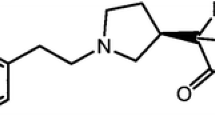Summary
Two methods for the direct separation of the enantiomers of trimetoquinol hydrochloride, denopamine and timepidium bromide were investigated, namely capillary zone electrophoresis (CZE) using cyclodextrins (CDs) (CD-CZE) and high-performance liquid chromatography (HPLC) using chiral stationary phases (CSPs). By CZE, separation of the enantiomers of trimetoquinol was successfully achieved when using β-cyclodextrin (β-CD), heptakis(2,6-di-0-methyl)-β-cyclodextrin (DM-β-CD) and β-CD polymer, but direct HPLC separation of the enantiomers was not successful. The enantiomers of denopamine were successfully separated by both CZE, employing DM-β-CD under acidic conditions, and HPLC, with cyclodextrin immobilized CSPs (CD-CSPs). Timepidium bromide, which is a racemic drug, was successfully enantioseparated by both CD-CZE and HPLC with CD-CSPs. The CD-CZE mode was selected as the optical purity testing method for trimetoquinol and denopamine because of the superiority of capillary electrophoretic (CE) techniques. Method validation results obtained clearly show that the CE method would be useful as an quality control method for assessing the optical purity of the drugs.
Similar content being viewed by others
References
P. D. Grossmann, J. C. Colburn (Eds), “Capillary Electrophoresis—Theory and Practice”, Academic Press, Inc., USA (1992).
S. F. Y. Li, “Capillary Electrophoresis—Principle, Practice and Applications”, Elsevier Science Publishers, USA (1992).
N. A. Guzman (Ed.), “Capillary Electrophoresis Technology”, Marcel Dekker, Inc., USA (1993).
J. Vindevogel, P. Sandra, “Introduction to Micellar Electrokinetic Chromatography”, Huthing, Heidelberg (1992).
S. Terabe, Trends Anal. Chem.8, 129 (1989).
H. Nishi, S. Terabe, J. Pharm. Biomed. Anal.11, 1277 (1993).
I. W. Wainer, D. E. Drayer (Eds.), “Drug Stereochemistry”, Marcel Dekker, Inc. New York, 1988, pp. 209–226.
A. M. Krstulvic (Ed.) “Chiral Separation by HPLC”, Ellis Horwood, Chichester (1989).
K. M. Kirkland, K. L. Neilson, D. A. McCombs, J. Chromatogr.545, 43 (1991).
S. R. Narayanan, J. Pharm. Biomed. Anal.10, 251 (1992).
Instruction manuals ULTRON ES-CD and ULTRON ES-PhCD, Shinwakako, Kyoto, Japan (1993).
J. Snopek, I. Jelinek, E. Smolková-Keulemansová, J. Chromatogr.609, 1 (1992).
R. Kuhn, S. Hoffstetter-Kuhn, Chromatographia34, 505 (1992).
S. Terabe, K. Otsuka, H. Nishi, J. Chromatogr. 666, 295 (1994).
T. J. Ward, Anal. Chem.66, 633A (1994).
M. Novotny, H. Soini, M. Stefansson, Anal. Chem.66, 646A (1994).
S. Fanali, J. Chromatogr. 474, 441 (1989).
S. Fanali, P. Bocek, Electrophoresis11, 757 (1990).
H. Nishi, T. Fukuyama, M. Matauo, S. Terabe, J. Microcolu. Separ.1, 234 (1989).
D. Y. Pharr, Z. S. Fu, T. K. Smith, W. L. Hinze, Anal. Chem.61, 275 (1989).
M. Sato, K. Ikezawa, T. Nagao, A. Kiyomoto, Oyo Yakuri19, 269, (1980).
H. Nishi, N. Fujimura, H. Yamaguchi, T. Fukuyama, J. Chromatogr.539, 71 (1991).
H. Nishi, Y. Kokusenya, T. Miyamoto, T. Sato, J. Chromatogr.659, 449 (1994).
H. Nishi, K. Nakamura, H. Nakai, T. Sato, J. Chromatogr. A,678, 333 (1994).
H. Nishi, K. Nakamura, H. Nakai, T. Sato, S. Terabe, Electrophoresis15, 1335 (1994).
S. A. C. Wren, R. C. Rowe, J. Chromatogr.603, 235 (1992).
S. A. C. Wren, R. C. Rowe, J. Chromatogr.609, 363 (1992).
T. Nagao, T. Ikeo, S. Murata, M. Sato, H. Nakajima, Jpn. J. Pharmacol.35, 415 (1984).
H. Nishi, N. Fujimura, H. Yamaguchi, W. Jyomori, T. Fukuyama, Chromatographia30, 186 (1990).
H. Tamaki, M. Tanaka, S. Murata, S. Harigaya, A. Kiyomoto, Jpn. J. Pharmacol. 22, 685 (1972).
Author information
Authors and Affiliations
Rights and permissions
About this article
Cite this article
Nishi, H., Nakamura, K., Nakai, H. et al. Enantiomeric separation of trimetoquinol, denopamine and timepidium by capillary electrophoresis and HPLC and the application of capillary electrophoresis to the optical purity testing of the drugs. Chromatographia 40, 638–644 (1995). https://doi.org/10.1007/BF02315130
Received:
Revised:
Accepted:
Issue Date:
DOI: https://doi.org/10.1007/BF02315130




